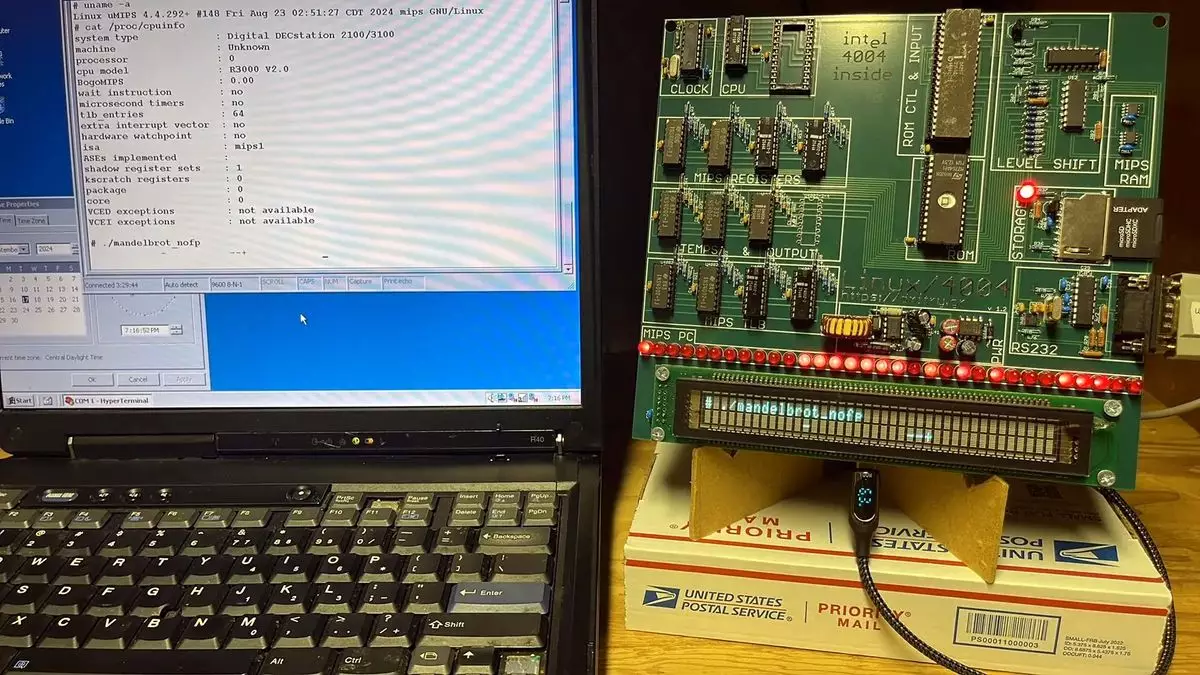Imagine the sheer audacity of making a cutting-edge operating system, conceived over three decades ago, run on a microprocessor that debuted two decades prior to its release. Dmitry Grinberg has embraced this challenge, paving a unique path in the tech world. With notable projects behind him, such as getting Doom to operate on a Def Con badge, Grinberg’s recent endeavor dwarfs these earlier feats. He has managed to coax the kernel of Debian Linux to boot on the Intel 4004, the first commercially available microprocessor launched way back in 1971.
This venture isn’t merely an act of nostalgia but a tribute to innovation. The Intel 4004 is the archetype of simplicity, featuring a meager collection of 2,600 transistors. Compared to contemporary processors, it possesses an astonishingly minimalistic architecture that primarily allows for addition and subtraction. Further hampered by the absence of logic operations and hardware interrupts, multitasking on this chip is nearly impossible—a true relic of an era when computing was in its infancy.
The project’s brilliance lies not just in Grinberg’s ability to make old hardware function but in the complexities of the engineering behind it. The necessity of creating an emulation environment to run something as complex as Linux on such inadequate hardware called for remarkable ingenuity. To facilitate this, Grinberg ingeniously designed a program that emulates a MIPS R3000 processor on the antiquated 4004. While the MIPS R3000 isn’t the newest of technologies either, its architecture was contemporaneous with the original iterations of Linux, making it a fitting choice.
Crafting additional hardware for emulation, Grinberg produced a custom circuit board equipped with period-specific components. Finally, he achieved the momentous event of booting Linux to a functional command prompt, indicating successful execution. However, this triumph came with its own share of conundrums, primarily related to performance.
The prime impediment to this ambitious project was the abysmal speed of the Intel 4004. With its clock speed operating at a mere 790 kHz—an unfathomable comparison to modern gigahertz processors—booting the Linux kernel proved to be an excruciatingly slow process. Initial estimations indicated that the kernel could take nearly nine days to boot—a time frame that seemed absurd but was reflective of the limitations inherent in the chosen hardware.
Grinberg’s relentless perseverance, however, soon came to the fore. With the help of optimization techniques and some cunning tweaks, he managed to lower the boot time to a mere 4.76 days. Although still humorously lengthy, this achievement adds a layer of awe to the entire endeavor. In an age where instant gratification reigns supreme, Grinberg’s achievement thrives on the tenacity of slow, meticulous engineering efforts.
The monumental event of booting Linux on hardware that technically should have been obsolete was expertly documented. Grinberg’s video showcases a clock whizzing by—spicing up the seemingly ludicrous prospect of watching an operating system boot for multiple days. It’s almost a performance art piece, encapsulating the patience and precision of both the creator and the onlookers intrigued by this collision of time and technology.
Though this undertaking serves no practical purpose, it exemplifies the spirit of innovation. In an era dominated by commercial viability, Grinberg’s project is a whimsical reminder of how far we’ve come. It deftly intertwines nostalgia with a challenge to conventional thinking, showcasing what is possible when we push the boundaries of what we perceive as inevitable.
Dmitry Grinberg has not only revived a piece of computing history but has also resurrected the spirit of tinkering that defined early advancements in technology. While he now faces the whimsical question of how to follow this remarkable feat, one can’t help but wonder if a project involving the once-legendary Doom game could be far behind. A notion arises: will Grinberg find a way to execute Doom with a ludicrous frame rate such as 30 frames per month? Undoubtedly, if anyone can make such fantasies a reality, it will be a mind like his.

